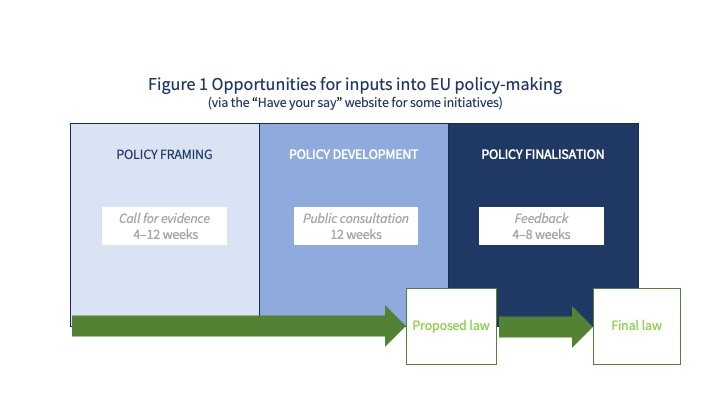How to provide feedback on upcoming EU policies and regulations – explained
- Common Agricultural Policy
- Common Fisheries Policy
- Food safety
Summary
This summary explains when and how non-EU countries can provide inputs into EU policy-making.
How to provide feedback on upcoming EU policies and regulations
Better Regulation Guidelines
Better Regulation Toolbox
Update
This summary explains when and how non-EU countries can provide inputs into EU policy-making.
Background
In order to improve the efficiency of the EU law-making process, the European Parliament, the Council and the Commission concluded an Interinstitutional Agreement on Better Law-Making in 2016.
The three EU institutions consider that public and stakeholder consultations, follow-up evaluations of existing legislation (“ex-post” evaluation), and impact assessments of new initiatives will help to achieve the objective of Better Law-Making.
Overview
European Commission (“Have your say”)
It is critically important that the interests of low- and middle- income countries are taken into account when new policies or regulations are being developed by the EU.
For certain new regulations and policies, the EU offers opportunities for stakeholders (including those from non-EU countries) to provide inputs into the policy-making process. Three types of input are possible (see Figure 1).
1 Call for evidence
Early in the policy-making process, the European Commission opens a call for evidence that describes the problem to be tackled, what the EU is trying to achieve, the options that are being considered, and the consultation strategy.
Cases that involve impact assessments take 12 weeks; other cases take 4 weeks.
2 Public consultation
The Commission may open a public consultation to collect more targeted information on the different options that are being considered before drafting the legislation. This feedback is usually collected using a questionnaire, and stakeholders generally have 12 weeks to respond.
3 Feedback
Where the Commission adopts a proposal for a new law, it will often ask for feedback from stakeholders.
- For new Regulations and Directives, for which the Commission has to consult both the Council of the EU and the European Parliament, the consultation lasts 8 weeks. The Commission provides a summary of this feedback to the Council and Parliament.
- For Delegated and Implementing Regulations, for which the Commission is responsible, the consultation lasts 4 weeks. The Commission assesses the feedback and provides an explanation of how the feedback was taken into account. Sometimes this feedback is referred to in the introductory explanation published with the new Regulation, and sometimes in the report of the Committee adopting the Regulation.
Public consultations are published on the “Have your say” website. The only step you need to take before providing feedback is to register on the EU platform.
World Trade Organization (ePing)
Many technical food safety regulations (e.g. on contaminants, maximum residue levels for pesticides, authorisations or prohibitions of pesticides, food additives, etc.) are based on opinions by the European Food Safety Authority (EFSA). These are not published on the “Have your say” website. However, where they could have an impact on trade, they are generally submitted to the World Trade Organization (WTO) Technical Barriers to Trade (TBT) Committee, and/or the Sanitary and Phytosanitary Measures (SPS) Committee.
At this stage, WTO member countries may comment on the proposal, usually within 60 days of notification. An overview of notifications can be found on the WTO’s ePing SPS & TBT Platform.
Comments or concerns about potential impacts can be submitted, via the National SPS notification authority of the country concerned, to the EU SPS Enquiry Point.
The regular AGRINFO Update newsletters highlight when the Commission opens an EU consultation or submits a notification to the WTO for comment. You can subscribe to AGRINFO Update here.
What are the major implications for exporting countries?
It is critically important to use these opportunities to provide feedback, to ensure that the interests of low- and middle- income countries are taken into account when new policies or regulations are being developed by the EU.
Resources
European Commission: Better Regulation: why and how
Interinstitutional Agreement between the European Parliament, the Council of the European Union and the European Commission on Better Law-Making
Sources
Online resources from the European Commission:
- Better Regulation Guidelines
- Better Regulation Toolbox
- Better Regulation Toolbox by chapters
Tables & Figures

Source: AGRINFO
Disclaimer: Under no circumstances shall COLEAD be liable for any loss, damage, liability or expense incurred or suffered that is claimed to have resulted from the use of information available on this website or any link to external sites. The use of the website is at the user’s sole risk and responsibility. This information platform was created and maintained with the financial support of the European Union. Its contents do not, however, reflect the views of the European Union.
